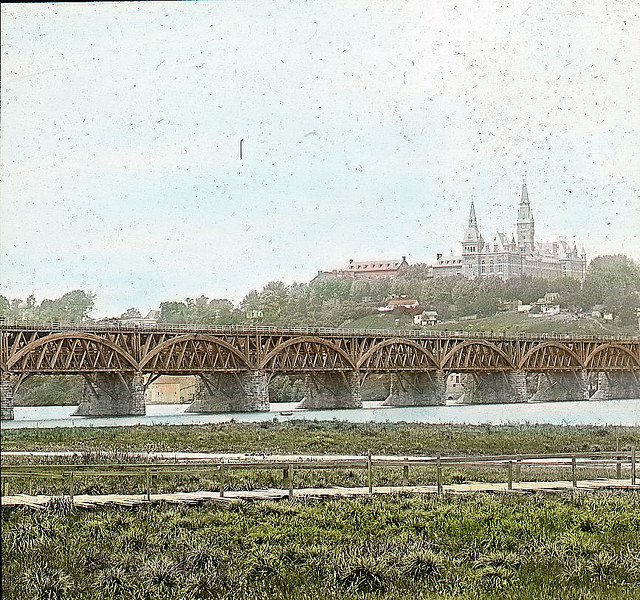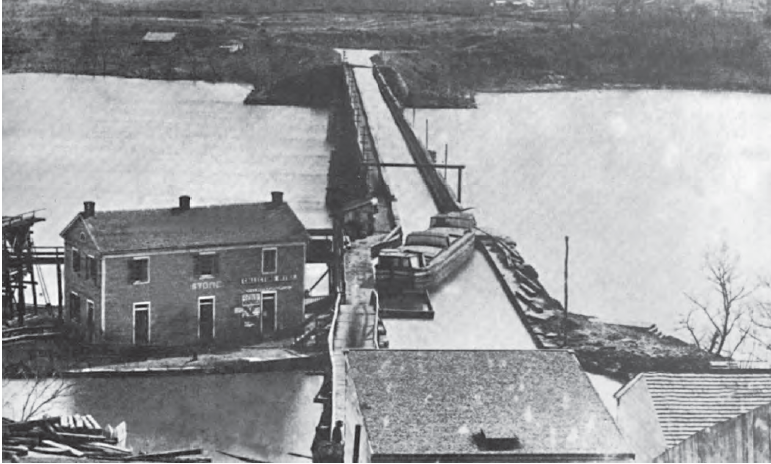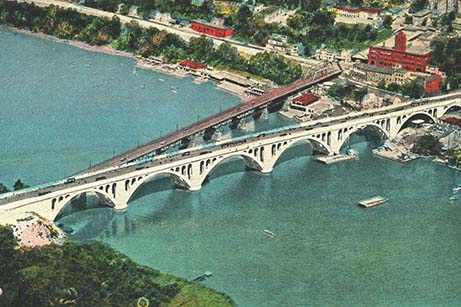elliot carter photo
by ELLIOT CARTER
This graffitied hangout in Georgetown is the stubby remnant of the Aqueduct Bridge, also known as the Alexandria Aqueduct. Traffic in Georgetown has always been bad, and this was an early attempt to relieve congestion on the C&O Canal.
The abutment pictured above, along with eight stone piers, served as the foundation for two separate wood, and then metal bridges.
Construction
Cofferdam consruction. NPS photo
Building a bridge across the Potomac was not an easy task. The river is 18 feet deep at this location, and construction had to go down through another 17 feet of silt before they could reach bedrock.
A set of (leaky) cofferdams were built that allowed workers to climb down 35 feet below the water surface. Boats would then lower massive stones down the hole to build up the piers. Once the piers were finished, a wooden trough was built on top of them. This was filled with water and linked the C&O Canal with the Alexandria Canal. Construction took ten years.
Civil War Era
During the Civil War the aqueduct was drained and boarded over to form a military roadway. This bridge provided a critical logistical connection to the defensive forts and batteries guarding the heights around Rosslyn. Civil War Washington was protected by a ring of such forts (called the circle forts).
After the war the government returned the bridge to the Alexandria Railroad and Bridge Company. They left the roadway intact until 1866, when it was turned back into an aqueduct.
The post-war aqueduct had major leakage issues. The Washington Post complained in 1885 that
"[the aqueduct's] present condition is very obnoxious to all persons who are fond of boating, for there is not a single arch under which they can go without receiving a drenching from the continual downpouring of water from the leaks above."
Metal Bridge
Streets of Washington photo
In 1886 the government bought the aqueduct and tore down the leaky wooden superstructure. An Army Engineer named Peter Hains (Hains Point is also named after him) designed an elegant iron truss bridge to rest on the piers. The iron bridge looked beautiful, but its construction was not sturdy enough for the large amount of traffic it carried. And weather was taking its toll on the stone piers.
Francis Scott Key Bridge
Congress authorized construction of a new stone bridge near the aging aqueduct in 1916 . The iron bridge remained in place, abandoned, until the Great Depression. In 1933 the Civil Works Administration dismantled the iron truss structure and left the piers in place to shield Key Bridge from dangerous ice flows. The stone abutment in Georgetown was preserved due to the efforts of The Georgetown Citizens Association, who successfully mounted a campaign to save it as a recreation spot.
WASHINGTON POST PHOTO
The stone piers stood there into the 1960's, when boating enthusiasts pressured Rep. Joel Broyhill (R-VA) to get rid of them, as the piers inhibited boat racing. According to the Washington Post, Broyhill asked the Army Corps of Engineers to blow the piers up as part of "a training exercise." The rubble could then be repurposed in Anacostia Park to build a seawall. The Arlington Historical Society got them to leave one pier in place as a historical marker, and it's still there today.
elliot carter photo








